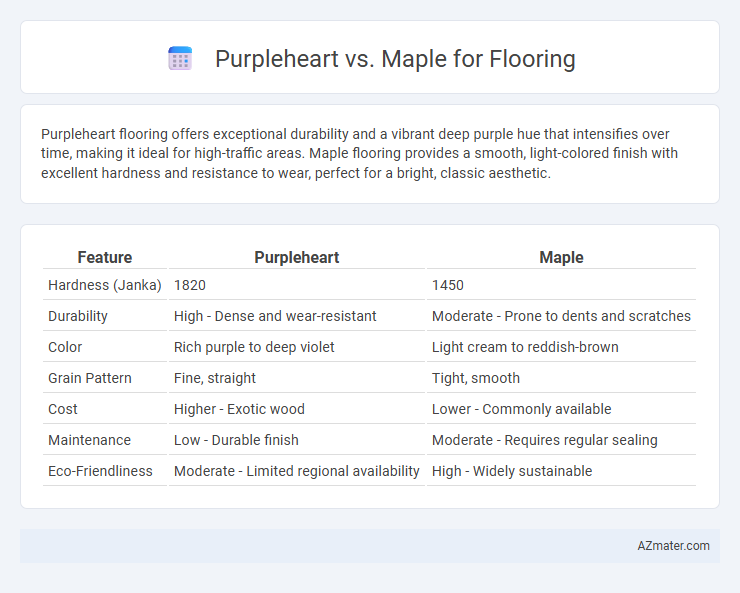Purpleheart flooring offers exceptional durability and a vibrant deep purple hue that intensifies over time, making it ideal for high-traffic areas. Maple flooring provides a smooth, light-colored finish with excellent hardness and resistance to wear, perfect for a bright, classic aesthetic.
Table of Comparison
| Feature | Purpleheart | Maple |
|---|---|---|
| Hardness (Janka) | 1820 | 1450 |
| Durability | High - Dense and wear-resistant | Moderate - Prone to dents and scratches |
| Color | Rich purple to deep violet | Light cream to reddish-brown |
| Grain Pattern | Fine, straight | Tight, smooth |
| Cost | Higher - Exotic wood | Lower - Commonly available |
| Maintenance | Low - Durable finish | Moderate - Requires regular sealing |
| Eco-Friendliness | Moderate - Limited regional availability | High - Widely sustainable |
Introduction to Purpleheart and Maple Flooring
Purpleheart flooring, derived from the Peltogyne genus, is prized for its rich purplish hue that darkens with age, offering durability and a distinctive aesthetic appeal in high-traffic areas. Maple flooring, sourced primarily from Hard and Soft Maple species, is renowned for its light, creamy color and fine, consistent grain that provides a smooth, durable surface ideal for both traditional and contemporary interiors. Both hardwood options deliver excellent strength and longevity, but Purpleheart's vibrant color contrasts with Maple's subtle elegance, making them unique choices in flooring design.
Origin and Availability of Purpleheart and Maple
Purpleheart flooring originates primarily from Central and South American rainforests, including countries like Brazil, Guyana, and Suriname, making it a exotic and less commonly sourced hardwood. Maple, on the other hand, is native to North America, particularly abundant in the United States and Canada, making it readily available and more affordable for flooring purposes. Due to its wide availability, maple enjoys a more consistent supply chain, whereas purpleheart's exotic origin can contribute to higher costs and limited stock.
Color and Aesthetic Differences
Purpleheart flooring exhibits a deep, rich purplish hue that darkens to a brownish-purple over time, creating a bold and exotic aesthetic ideal for statement interiors. Maple flooring offers a light, creamy color with subtle grain patterns, delivering a clean, bright, and timeless appearance suited for versatile design schemes. The stark contrast between Purpleheart's intense color saturation and Maple's pale neutrality allows for distinct styles ranging from dramatic to classic in flooring choices.
Durability and Hardness Comparison
Purpleheart flooring boasts a Janka hardness rating of approximately 2,520, significantly surpassing Maple's rating of around 1,450, making Purpleheart notably more resistant to dents and wear. Its exceptional density and durability ensure superior longevity in high-traffic areas, while Maple provides a smoother, more uniform surface with moderate durability suitable for residential flooring. Purpleheart's rich purple hue and robustness make it a premium choice for those prioritizing durability and hardness in hardwood flooring.
Installation Process for Both Wood Types
Purpleheart flooring requires precise acclimation and moisture control due to its dense fiber structure, ensuring stability during installation. Maple, known for its uniform grain and moderate hardness, allows for easier nailing or gluing, reducing installation time and complexity. Both wood types benefit from professional-grade adhesives and moisture barriers to prevent expansion and maintain long-term durability.
Maintenance Requirements: Purpleheart vs Maple
Purpleheart flooring demands minimal maintenance due to its natural resistance to moisture, scratches, and pests, making it ideal for high-traffic areas with less frequent upkeep. Maple flooring requires regular sealing and refinishing to maintain its appearance and protect against dents, scratches, and moisture damage. Both woods benefit from routine cleaning with a soft broom or vacuum and avoiding excessive water exposure to extend their lifespan.
Cost Analysis and Value for Money
Purpleheart flooring commands a higher price per square foot due to its exceptional durability and rich, deep color that darkens over time, making it a premium choice in hardwood flooring. Maple offers a more budget-friendly option with consistent hardness and lighter tones, appealing to those seeking cost-effective yet reliable flooring. When considering long-term value for money, Purpleheart's superior resistance to wear and unique aesthetic justify the initial cost for high-traffic areas and luxury applications, whereas Maple provides a practical balance of affordability and performance for general residential use.
Sustainability and Environmental Impact
Purpleheart flooring offers exceptional durability and is naturally resistant to decay, making it a sustainable choice due to its long lifespan and reduced need for replacement. Maple is a fast-growing hardwood with a lower environmental footprint when sourced from responsibly managed forests, providing a renewable option with minimal ecosystem disruption. Both woods can be sustainably harvested, but Purpleheart's slower growth rate requires careful sourcing to ensure environmental preservation.
Pros and Cons of Purpleheart Flooring
Purpleheart flooring offers exceptional durability with a Janka hardness rating of 2,520, making it highly resistant to wear and impact compared to softer woods like maple, which has a Janka rating of 1,450. Its rich, deep purple color darkens over time to a warm brown, providing unique aesthetic appeal but may require occasional UV protection to maintain vibrancy, unlike maple's consistent light tone. However, Purpleheart can be more challenging to work with due to its dense, oily nature, potentially increasing installation time and costs, whereas maple is easier to cut and finish.
Pros and Cons of Maple Flooring
Maple flooring offers exceptional durability and hardness, making it ideal for high-traffic areas and resistant to dents and scratches, with a Janka hardness rating of around 1450. Its light, consistent grain pattern provides a clean, modern aesthetic that brightens spaces but may show wear more visibly over time compared to darker woods like Purpleheart. However, Maple is prone to yellowing with prolonged sun exposure and can be more susceptible to moisture-related issues, requiring proper sealing and maintenance.

Infographic: Purpleheart vs Maple for Flooring
 azmater.com
azmater.com